By: Léon C. Rochotte, Ex Petty Officer, French Navy Engineer,
Retired (Submission: June 1998 - Draft 2) - Version intégrale
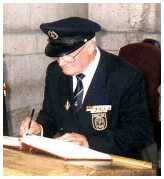 Editor Note: About the author. Léon C. Rochotte entered the French Navy in 1949. He was on board the frigate FMS LA GRANDIÈRE (F 731) in Korean Waters from July until December 1950 and participated in the Inchon and Wonsan invasions. LA GRANDIÈRE was integrated into the Fourth Frigate Squadron (F4) and placed under British command for the operation. Rochotte left the French Navy in 1956 as a Petty Officer of the French Fleet Air Arm (15F-"Corsair" F4U7). He is a retired methods engineerand a member of the French Korean Veterans Association (A.N.A.F.F. ONU - R.C.) and the British Korean Veterans Association (B.K.V.A. South London Branch). He resides in St. Michel Sur Meurthe, France. Accounts involving HMS MOUNTS BAY (F 627) are extracted from Don Giles article "HMS MOUNTS
BAY in Korean Waters" originally published in french, in "Le Piton", FKWVA Bulletin, January 1998. Giles served in the Royal Navy aboard MOUNTS BAY in 1950 till 1952. MOUNTS BAY served as the F4 British flagship during the Inchon invasion in September 1950. It's force consisted of screen group, TG 90.4, then minesweeping group TG 95.6. He was on board MOUNTS BAY in Korean waters during the Inchon invasion. He is retired, and a member of the British Korean Veterans Association and resides in
Lincoln, United Kingdom. Others contributing to this article include Rear Admiral (then Lieutenant) Louis Tailhades, French Navy, Retired, and former French sailors, Lucien Charron, Gaston Brockly and Marcel Favry, all retired. Tailhades, Charron, Brockly and Favry all served aboard LA GRANDIÈRE during this period. (The author states that the opinions, citations, disgests and interpretations expressed in this article are his alone.)
Editor Note: About the author. Léon C. Rochotte entered the French Navy in 1949. He was on board the frigate FMS LA GRANDIÈRE (F 731) in Korean Waters from July until December 1950 and participated in the Inchon and Wonsan invasions. LA GRANDIÈRE was integrated into the Fourth Frigate Squadron (F4) and placed under British command for the operation. Rochotte left the French Navy in 1956 as a Petty Officer of the French Fleet Air Arm (15F-"Corsair" F4U7). He is a retired methods engineerand a member of the French Korean Veterans Association (A.N.A.F.F. ONU - R.C.) and the British Korean Veterans Association (B.K.V.A. South London Branch). He resides in St. Michel Sur Meurthe, France. Accounts involving HMS MOUNTS BAY (F 627) are extracted from Don Giles article "HMS MOUNTS
BAY in Korean Waters" originally published in french, in "Le Piton", FKWVA Bulletin, January 1998. Giles served in the Royal Navy aboard MOUNTS BAY in 1950 till 1952. MOUNTS BAY served as the F4 British flagship during the Inchon invasion in September 1950. It's force consisted of screen group, TG 90.4, then minesweeping group TG 95.6. He was on board MOUNTS BAY in Korean waters during the Inchon invasion. He is retired, and a member of the British Korean Veterans Association and resides in
Lincoln, United Kingdom. Others contributing to this article include Rear Admiral (then Lieutenant) Louis Tailhades, French Navy, Retired, and former French sailors, Lucien Charron, Gaston Brockly and Marcel Favry, all retired. Tailhades, Charron, Brockly and Favry all served aboard LA GRANDIÈRE during this period. (The author states that the opinions, citations, disgests and interpretations expressed in this article are his alone.)
Aboard FMS LA GRANDIÈRE (F731)
On 8 September 1950, Commanding Officers of the Fourth Frigate Squadron were informed they would be participating in an upcoming secret operation. Contact with anyone outside of other commanding officers of the squadron was prohibited and strict radio silence was ordered. The following day, LA GRANDIÈRE's Commanding Officer received his orders in a sealed envelope and instructed not open it until after her departure at noon on the 10th. After getting underway, the Captain read his orders that assigned his ship to Task Force 90 under command of U.S. Navy Rear Admiral Lyman A. Thackrey. TF 90 was assigned a mission to support an amphibious operation at Inchon, Korea, some 300 kilometers northeast of Pusan where enemy forces were less than 50 km away from the city.
We were to convoy with other operational groups to be in place for direct support of the amphibious landing. The operation also included a U.S. Marine assault force and, because of heavy mining in the area, minesweepers. The orders required the following operational groups to be put in place according
a precise date and timing: the minesweepers, the Marines assault forces, the ships giving covering fire in concentric arcs depending on range of their artillery, and then, in the open sea, the carriers.
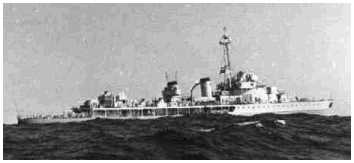 LA GRANDIÈRE (as CTU 90.04.3) joined Attack Force 90.42 and three minesweepers USS PARTRIDGE (AMS 31), USS OSPREY (AMS 28) and USS MOCKING BIRD (AMS 27). Also in the convoy were tugboats YTB406 and YN101, and three other fleet ocean tugs USS ARIKARA (ATF 98), USS LIPAN, and USS CREE (ATF 84) with their floating landing stage elements. The group was the first to depart Sasebo, Japan, while other groups had departed from several ports on the East Coast of Japan. We were passed on route by those groups who
had to be in position before the landing operations.
LA GRANDIÈRE (as CTU 90.04.3) joined Attack Force 90.42 and three minesweepers USS PARTRIDGE (AMS 31), USS OSPREY (AMS 28) and USS MOCKING BIRD (AMS 27). Also in the convoy were tugboats YTB406 and YN101, and three other fleet ocean tugs USS ARIKARA (ATF 98), USS LIPAN, and USS CREE (ATF 84) with their floating landing stage elements. The group was the first to depart Sasebo, Japan, while other groups had departed from several ports on the East Coast of Japan. We were passed on route by those groups who
had to be in position before the landing operations.
On the 11th, we received a message advising that a typhoon had formed and its predicted path would take it along the West Coast of Korea, threatening the operation. The storm veered and the operation continued. The convoy arrived off Inchon the night of 14 September. At midnight, under a dark
night with a new moon, the convoy progressed along the long channel leading to Inchon. All lights were extinguished. The channel was narrow and subjected to strong streams and, given the presence of mines, minesweepers were the first to enter. They threaded their way between the groups of islands clearing
the way for the many warships (up 230) taking part in this precarious operation.Given the number of ships operating in this small area, there were fortunately, no accidents.
Aboard HMS MOUNTS BAY (F 627)
On 11th September, the Royal Navy frigate MOUNTS BAY sailed from Pusan to rendezvous with the main invasion force off the West Coast of Kyushu Island. We had assumed escort duties along with frigates HMS WHITESANDBAY (F 633), MORECOMBE BAY (F 624), and Royal New Zealand Navy's HMNZSs TUTIRA (F 517) and PUKAKI (F 424). We later joined the French Navy's LAGRANDIÈRE and American frigates USS BAYONNE, USS NEWPORT and USS EVANSVILLE. The sea and wind had abated allowing for a more comfortable passage through the Yellow Sea to our convoy's ultimate destination, Flying Fish Channel off Inchon.
By the 13th, the tempo of the air and sea bombardment increased in intensity with the addition of the Royal Navy's light cruisers HMSs JAMAICA and KENYA who had the task of destroying five 76mm shore batteries on Wolmi Do Island which dominated the approach to Inchon Harbor.
Captain J.H. UNWIN, MOUNTS BAY's Commanding Officer, had the responsibility to form an outer protective screen approximately 50 miles long and 40 miles to the south of the Inchon approaches. The task was to prevent interference in the landing zone from enemy vessels, suicide craft, swimmers, floating mines, movement of the enemy between the islands and mainland, and to rescue any downed aircrews. Placed under Captain Unwin's command were WHITESAND BAY and MORECAMBE BAY along with the RNZS TUTIRA (ex Loch Morlich) and RNZS PUKAKI (ex Loch Achanal), both Loch Class Frigates armed with a single
4" gun, 20mm and 40mm AA plus 2 squid AS weapons. The US presence in the command were the USS BAYONNE, NEWPORT and EVANSVILLE, all escort vessels of the Ashville class (Lend Lease River class). All three lightly armed with three x 3"guns, ten x 20mm AA weapons and depth charges.The final link in the screen was the French contribution FMS LA GRANDIÉRE, a Tropical Type Sloop (frigate) of some 2,600 tons, armed with three x5,5" (138mm) guns in single mountings, plus eleven 20mm oerlikons AA and four 40mm bofors AA, depth charges (66) and mortars AS weapons. (Don Giles wrote: Mounts Bay in company of La Grandière had previously been engaged on convoy escort and protection duties and, when in harbor, cemented this working relationship by the exchange of rum, wine, cigarettes gauloises
and good hospitality. Red wine mixed with rum produced a 'tot' of 200% octane rating, more suited to aircraft fuel than social drinking but even so very much appreciated.. Not edited...)
During the landing on the 15th, the ships on the outer screen were all at battle stations and remained on patrol keeping on constant vigil for signs of reaction by the North Koreans. At 2030 the following day, our radar watch picked up a contact that failed to respond to light challenges.Our "B" guns turret opened fire with six 2-inch illumination flares. In the light of the flares we found it was an ROK minesweeper enroute to join the minesweeping flotilla operating under our protection in the
Inchon approaches.
On the 18th, MOUNTS BAY and LA GRANDIÈRE, opened fire with 40mm anti-aircraft guns, destroying quite a few floating mines. North Korea had laid a number of Russian contact mines using junks and sampans.
On 25th September with the UN forces about to enter Séoul and the link up with the 8th Army from the south imminent, naval priorities were re-assessed and as a result the outer protection screen was disbanded. Mounts Bay entered Inchon harbour securing alongside USS WINSTON (AKA 94)for replenishment. The reassessment determined it was necessary to take into account the increased danger from sea mines both moored and floating. So far a total of 54 mines had been sighted the group. Both USS MANSFIELD (DD 728), USS BRUSH (DD 745) and two Albatross-class ROK minesweepers had been damaged and the minesweeper, USS MAGPIE (AMS 25), sunk off Pohang, by mines. Aside from the physical damage to ships, there were casualties among the crews, something that concerns all Sailors.
On board LA GRANDIÈRE
We observed a U.S. warship which had been damaged by a mine and saw first hand what a mine can do to a ship. The ship was possibly USS BRUSH (DD 745). Her stem was entirely destroyed. One of our seamen remembered the event vividly and said, "...the whole stem, including the first gun turret, looked as if had been cut with a saw. The ship was proceeding at slow speed and under its own power. Her stern was riding high and her propellers were nearly out of the water." Another said, "There were numerous casualties, maybe fifty.... I believe perhaps as five sailors were killed... That was credible, because as our navy , crew's quarters are located at the fore part of the ship, near the magazines.... poor guys...R.I.P.!"
On board MOUNTS BAY
Once ships had been relieved of protection duties off Inchon, they were placed in minesweeping group TG 95.6, under command of Captain Richard T. Spofford USN. Included were MOUNTS BAY, her French companion LA GRANDIÈRE, WHITESAND BAY, PUKAKI, TUTIRA and two ROK minesweepers. After replenishing her stores, we went on patrol with ROK 502 searching inlets and bays for minelaying junks and sampans. At 0230 on the 2nd, MOUNTS BAY radar watch detected a "skunk" (unidentified target) which failed to reply to challenges. On closing in on the target, we fired a shot across the boat's bow bringing it to a stop. Our attempts to interrogate the crew proved unsuccessful because of the language problem. The boat, a junk, was taken in tow and the following day handed over to ROK 502 for investigation.We experienced minimal direct opposition from North Korean naval units, but shore batteries was a concern and the threat from Russian made moored and floating mines was constantly on the increase. On the 10th, we returned from patrol and secured alongside USS PIEDMONT a fleet repair ship anchored off Inchon for refit and replenishment of stores.
On Board LA GRANDIÈRE
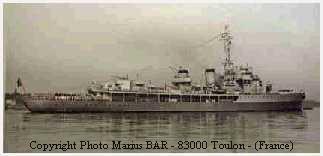 On the 2nd of October our patrol was interrupted. Anchored off Wolmi Do Island we received a visit by Rear Admiral L. A. Thackrey, Commander, Amphibious Force Far East (TF 90). His visit was one of many visits by U.S. Officers of flag rank during the operation.
On the 2nd of October our patrol was interrupted. Anchored off Wolmi Do Island we received a visit by Rear Admiral L. A. Thackrey, Commander, Amphibious Force Far East (TF 90). His visit was one of many visits by U.S. Officers of flag rank during the operation.
(Addition of the author, not edited: The French ship would received many visits of many US Officers of high rank, coming aboard often with impressive staff. "La Grandière" had become quickly famous in all the Yellow Sea because of the extraordinary "wine cellar" of her Captain CF Urbain CABANIÉ FN. Respectfully towards all these high ranked RN, USN or USMC Officers and their numerous staff, I would to say that we have aboard the "La Grandière" a high trained
team to secure perfectly well our visitors all along their perillous going down on our accommodation ladder to their motor launches , weathers conditions becoming often suddenly bad in these seas...)
LA GRANDIÈRE resumed her patrol on 6 October. Three days into the patrol, a Korean interpreter who had been on board MOUNTS BAY joined us. MOUNTS BAY had managed to resolve her problems interrogating crews of suspected hostile vessels with the help of the interpreter. He was transferred from MOUNTS BAY to LA GRANDIÈRE by cable, with the mail, over the turbulent waters, while the two ships sailed "bord à bord" at full speed. After his hair-raising cable trip it took a while for him
to stop shaking. Talking with him later, he told us he was a meteorologist in civilian life, and described life in Korea during the Japanese occupation and after the arrival of the Communist forces. He was and friendly and intelligent man and was quickly adopted by our crew.
During this period we experienced "Air Raid Warning Red" conditions virtually everyday, but an air attack never seemed to materialize. The warnings were due to friendly aircraft (which had started to use the recently captured airfield at Kimpo) overflying our area but failing to activate their IFF (Identification Friend or Foe) transmitters. These failures resulted in ships constantly having to close up and send crews to Battle Stations. After constantly responding to so many "false alarms" the crews became somewhat complacent. One day our gunners were surprised when LA GRANDIÈRE was suddenly "jumped" by a MiG. One of our gunners remembers the situation well. "...it was so sudden, and in the labyrinth of the islands our radar was inoperative. The MiG literally jumped over
the ship, skimming the mast. Surprised, we quickly revolved our antiaircraft weapons as we heard the roar of jet engines getting louder. Our 40mm and 20mm guns opened fire as the target approached flying close to the water, zero azimuth. Because angular speeds were too high we were unable to hit the target. Luckily, two U.S. fighters were nearby (I believe they were the new F-86 Sabres). (Not edited: One second later, the Yanks were talking rubbish and obscene language on the radio...believe me...! At the point
we could regret to have sent them Monsieur de La Fayette ! but we did as we have not heard the radio; better to be deaf in that case...) Short time later, the Yanks were able to chase the MiG away. It was interesting to listen to their somewhat bawdy radio chatter as they closed on their target."
 |
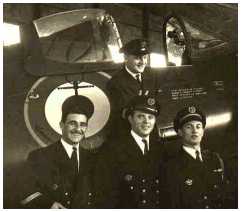 |
Corsairs on the flight deck during flight ops
off Korea |
M. Rochotte, standing on the step of
French Corsair F4U7 |
On 14 October, LA GRANDIÈRE was anchored off Inchon. Naval requirements and strategy were further re-assessed, with the decision to disband minesweeping group TG 95.6. Minesweeping operations in the area had downgraded reflecting the succes of the R.O.K. and U.S. sweepers operating in the area. The decision resulted in the return of MOUNTS BAY to convoy and general duties and the assignment of our ship to provide escort for an invasion at Wonsan on Korea's East Coast. On the 16th, aboard USS MOUNT MC KINLEY (AGC 7), the flagship, the new Commander CTF 90, Rear Admiral J. H. Doyle, USN, presented the
plans for the landing operation at Wonsan. LA GRANDIÈRE and four other frigates (WHITESAND BAY, MORECAMBE BAY, PUKAKI and TUTIRA) set sail on the 17th escorting five troopships carrying a brigade of Marines. The route took us through the Korean Straits and into the Sea of Japan arriving on the 21st at the entry channel to Wonsan. The channel was heavily mined, and two US minesweepers, USS PIRATE (AM 275) and USS PLEDGE (AM 277) had been sunk on the 12th by mines. Our convoy received orders to stop and maintain our position in the open sea. The invasion was stalled. Wonsan harbor was impassible, it was covered with Russian mines! We maintained that position until the 25th when our convoy was given the go-ahead to proceed. We sailed through the channel at low speed, slowing even more and occasionally stopping when it appeared a mine threatened us.
We were all worried, scared is probably more descriptive of our feelings.One of our seamen especially remembered one particular event. "I was on Night Watch on the Navigation Bridge, looking for floating mines," he said, "Suddenly, through my binoculars I caught sight of contact mine floating on the surface off our starboard, dancing gently in the swells.The convoy was lined up behind us. I turned to the Watch Officer and said, 'Do you see what I see, sir?' He replied that it was the second mine he saw in the last two or three miles. Then to my surprise the lieutenant ordered me to stay quiet and not sound the alarm. 'You understand my boy,' he said, 'because if the troopships in the convoy know that there are mines out there, they'll be frightened and will hold up until the channel is
wept again. Anyway, the mine's too far away to shoot at. Just shut up...OK?' I went back to my watching post, making a prayer to our holy God than if it was another of those f....d (edited...) mines ahead, may someone could see it in the nick of the time"
Thanks to the US and ROK minesweepers, the area was fairly cleared enough for the Marines to land at Wonsan without any opposition from the enemy since the port had already been secured by land forces. The South Korean forces were already in this important port north of the 38th parallel where the rest of the "X Corps" was expected. The Wonsan invasion failed and that was an embarrassement to all of us. The same day LA GRANDIÈRE and the other frigates set sailed to Sasebo, joining MOUNTS BAY at sea,
arriving on 27th October, i.e. after 47 continuous days at sea without land contact. It was cold and it was snowing...
LA GRANDIÈRE remained at Sasebo until 15th November. Naval operations seemed at a standstill. UN forces had got well beyond the 38th parallel and the enemy seemed beaten. A last mission was ordered. On 17th November, we sailed to Chinampo, north of the 38th parallel on the west coast, to transport about 40 US sailors. Chinampo is the port of Pyongyang on the estuary of the Taedong river.. On 19th we anchored off this port to land our passengers. During the night of 21st November, we received a message
from the Admiral of the French Naval Forces in the Far East. The LA GRANDIÈRE had to return to Indo-China waters as a result of the Cao-Bang french military disaster at Tonkin (North Viêt Nam)....
This ended the French naval presence in Korea and our participation in what was to be "a forgotten war."
FRENCH and ENGLISH in KOREAN WATERS: Operation CHROMITE
Inchon landing - September 15 th 1950
(Draft 1)
I am a French Veteran (Navy) of the Indochine (Viêt Nam) and Korean Wars, **** etc...
(British accounts adapted from my friend Don Giles, Malaysian and Korean Wars Vet.)
I served aboard the FMS LA GRANDIÈRE (F731), a frigate, Captain Urbain E. CABANIÉ FN. We were in the Korean waters since July 29th and have been immediatly assigned to escort duties between SASEBO (Japan) and PUSAN. Twelve successive convoys transporting troops and various cargoes took place without any incident up to 3rd September, except for some submarine threats and for some sea damages cause by the dreadful weather, but which was repaired quickly and efficiently at the Sasebo docks. During one of these busy duties, LA GRANDIÈRE's alarm rattlers sounded sending the ships company to action stations. This was the result of a probable echo of our ASDIC. Quickly depth charges and attack crews closed up and LA GRANDIÈRE moved for the hunt. So, in a very short time, by use of our throwers and rails, a full pattern of depth charges was dropped in the sea over an area approximately 100 x 130 meters (yards) and provoked enourmous water disturbances after explosion. But contact was lost and wreckage indicating a possible destruction was not found . Captain CABANIÉ called off the attack.
During this period the dutch destroyer HRMS EVERTSEN ran aground hardly on the shallows in the Korea's south archipelago, and was towed to port having been refloated.
On July the 4th General Douglas McArthur, who was placed in overall command of the UNITED NATIONS Forces in Korea had called the first meeting of many to outline his plan for a seaborne landing behind enemy lines to attack communications and lines of supply for :
- to relieve the pression of the ennemy around the PUSAN PERIMETER
- to go over into the offensive.
Operation Plan 100 subsequently code-named CHROMITE started to take shape and despite many objections McArthur's plan was adopted and the wheels of CHROMITE started to turn.
Placed in overall command of the ship-borne operation was Admiral Arthur Strubble, Commander in Chief of the U.S. Seventh Fleet. The naval force consisted of some 230 vessels including Royal Navy, Royal Australian, Canadian, New Zealand and French Navy. The largest warship to take part in the landing was the USS MISSOURI BB63 (The Mighty Mo) an Iowa class battleship of some 45,000 tons armed with 9 x 19" (406mm) guns in three turrets capable of firing a 1.2 ton shell over twenty miles. Her arrival in the command provoked cheering from the US sailors, who has been very upset by the dramatic grounding of this ship a few weeks earlier in the Chesapeake Bay.
These forces were split in several groups of which the group of escort ships to which LA GRANDIÈRE belonged, made up of frigates and corvettes from various countries, and placed under the command of Captain Unwin of the Royal Navy, commander of the frigate HMS MOUNTS BAY (F637) arrived in korean waters on the 10th August and the month consisting of convoy duties with LA GRANDIÈRE and other frigates and also close inshore support bombardments assisted by HMCS ATHABASCAN, CYUGA and HMAS BATAAN.
In command of the landing force was Major General Edward Almond, United States Army. His command designated as X Corps consisted of the 1st and 5th Marine Corps and the 7th Infantry Division, a total of some 70,000 men.
On the 5th of September the main landing force sailed from Yokohama en route to join other forces and escorts off Pusan. Typhoon Kexia straddled the line of advance with winds up to 125 mph (near 200 km/h) causing mountainous seas and difficult conditions. Much damages was caused to ships and equipment and seasickness was rife.
On 8 September 1950 LA GRANDIÈRE (F731), as CTU 90.04.3 joined Attack Force 90.42 with three minesweepers: USS PARTRIDGE (AMS 31), USS OSPREY (AMS28) and USS MOCKING BIRD (AMS 27). Also, under our protection in our convoy were other ships of the "Pontoon Movement Unit" : tugboats YTB406 and YN101, plus three fleet ocean tugs USS ARIKARA (ATF98), LIPAN and USS CREE (ATF84), with their floating stage elements. Our group was the first to depart Sasebo Japan, proceeding at slow speed to arrive off Inchon during the night of 14th to 15th September.... We were passed en route by other groups who had to be in position before the landing. Preliminary air strikes against the landing zone in and around Inchon commenced in earnest on the 10th of September with the remainder of the convoy sailing from Kobe on the 11th including the command ship USS MOUNT McKINLEY (AGC7) with General Douglas McArthur aboard.
On the 11th of September HMS MOUNTS BAY (F627) sailed from Pusan to rendezvous with the main invasion force off the west coast of Kyushu Island to take up escort duties along with HMS WHITESAND BAY (F633), MORECAMBE BAY (F624), HMNZS TUTIRA (F517) and PUKAKI (F424), plus the USS BAYONNE, NEWPORT and EVANSVILLE and joined at sea FMS LA GRANDIÈRE (F731) and her Pontoon Movement Unit. The seas and wind had abated allowing a more comfortable passage through the Yellow Sea to the convoys ultimate destination Inchon. At 17.03 on 13th September whilst escorting the convoy through the Yellow Sea MOUNTS BAY's ASDIC team reported a possible submarine contact and commenced a depth charge attack. A full pattern of depth charges were dropped without any distinguishable result. Further AS sweeps failed to regain contact and the attack was called off.
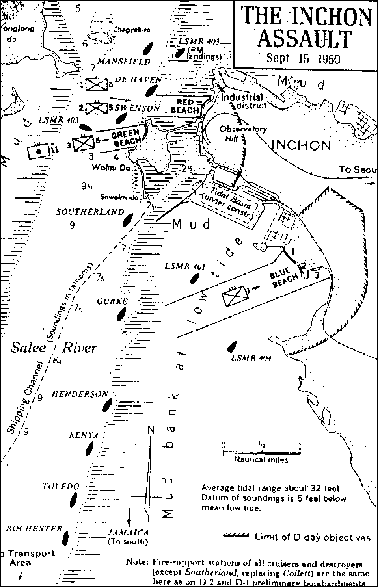
13 September 1950 : D Day -2 . The tempo of the air and sea bombardments increased in their intensity. TG 90.6 is en route to Inchon early in the morning. USS ROCHESTER (CA124) joined the formation. The US destroyers formed column led by USS MANSFIELD (DD728) and proceeded up Flying Fish channel toward Inchon. The channel is mined. USS MANSFIELD sighted 12 mines abeam to port 1,000 yards and fired on mines with small arms. MANSFIELD is with USS DE HAVEN and SWENSON proceeding in the Salee River and entered the harbor. Anchored in harbor they adjusted heading at anchor to bring guns to bear and commenced firing pre-arranged fire on targets, primarily gun emplacements. All along the Salee River, to the south, the cruisers USS SOUTHERLAND, GURKE, HENDERSON, TOLEDO, the british HMS JAMAICA and KENYA were on fire-support stations bombarding targets in Inchon area. Post Meridiem, the US destroyers were proceeding underway out of harbor at flank speed. They received counterbattery fire from Wolmi-Do and returned fire receiving no damage except USS SWENSON (one casualty) and USS COLLETT which have received hull damage. A total of twenty five splashes were observed in the immediate vicinity of which five were close aboard USS MANSFIELD. The Destroyers rejoined TG 90.6 and formed A/S screen to protect main forces on arrival Inchon approaches.
14 September 1950: D Day -1 : Element of TG 90.6 formed column in the morning and proceeded again up Flying Fish channel to Inchon area. USS MANSFIELD DD728 is column leader of the Destroyers unit. About noon, Cruiser Element commenced bombardment of Inchon area. Air strikes are in progress on Wolmi-Do and Inchon area. MANSFIELD and the Destroyers are on station assigned for pre-arranged fire in the close vicinity North East of Inchon. As in the precedent action, destroyers were proceeding down Flying Fish channel in the afternoon and rejoined TG 90.6 main force to form A/S screen.
D DAY - 15 September 1950: At midnight on the 14th, under a dark night with a new moon, FMS LA GRANDIÈRE F731 and her pontoon movement unit arrived off the Clifford islands. We progressed along the Flying Fish Channel which led to Inchon. All lights were switch off. The channel was narrow and subject to strong streams, the minesweepers went first and threaded their way between the groups of islands. A lot of warships took part in this precarious conditions. There was no accident... En route in the Salee River we were passed by element TE 90.67 USS MANSFIELD, DEHAVEN, SWENSON, HENDERSON, GURKE. USS SOUTHERLAND (DDR743) joined the column to replace USS COLLETT.
At 05.20 with all hands at action stations the combined assault force entered the Inchon narrows and the final pre-landing bombardment commenced. Proceeding along the Salee River before dawn, pontoon unit's convoy of LA GRANDIÈRE came within view of Wolmi-Do where the Marines were just preparing to land. Covering fire was given by all ships, first from the destroyers then the cruisers and the battleships as USS MISSOURI BB63 in the open sea firing salvos with all her nine 19" (406mm) guns ... Assault aircraft took off from the carriers. With our convoy we sailed ahead the bow of LSM'S(R) sending volleys of rockets to the shores of Inchon... What a firework... The hell ...
At 06.30 the American 3rd Battalion, 5th Marine Corps landed on Wolmi-Do island (designated "Green Beach") and within one hour and thirty minutes overcame its defenders. The island of So-Wolmi-Do on the southern tip of Wolmi-Do is connected by a causeway . USS SOUTHERLAND remain at fire-support station south of So-Wolmi-Do. We were passed again by US destroyers, firing to protect operations on "Green beach" and "Red Beach": USS MANSFIELD DD728, heading off Chogyak-To islet, DE HAVEN and SWENSON. Our gallant tugboats with their floating stage elements could take place ... 0635: First landing wave arrived on Wolmi-Do. 0647: Second landing wave arrived on beach. 0651: Third landing wave arrived on beach. At 0709 Wolmi-Do and So-Wolmi-Do are reported secured. With both offshore islands secured the main force prepare to land at Inchon but due to a tidal range of some 32 feet (about 3.5 meters) conditions were not immediately favourable. At 17.30 on a flood tide the main assault on "Red" beach (north of Wolmi-Do) and "Blue" beach (south the port of Inchon) took place. Within 24 hours the landing area was secured and the push inland towards Seoul commenced.
During the afternoon, pontoon unit's escort duty perfectly complited, LA GRANDIÈRE had to sail down Flying Fish channel towards her assigned patrol zone to the north of the island of Cheoul. We met again the frigates which shared the same patrol zone in replacement of the TG 90.6. and our British companion HMS MOUNTS BAY Captain J.H. UNWIN RN in command of the Fourth Frigate Squadron (F4) Commonwealth we were integrated.
Captain J.H. Unwin had been given the responsibility of forming an outer protection screen approximately 50 miles long and 40 miles to the south of the Inchon approaches. The screen's task was to prevent interference within the landing zone from:
a) enemy vessels
b) suicide craft
c) swimmers
d) floating mines
e) prevent movement between islands and mainland
f) prevent movement between islands
g) rescue downed aircrew
Placed under Captain Unwin's command were also HMS WHITESAND BAY and MORECAMBE BAY along with the RNZS TUTIRA ex "Loch Morlich" and RNZS PUKAKI ex "Loch Achanalt" both Loch Class Frigates armed with a single 4" gun, 20 and 40mm AA plus 2 squid AS weapons. The US presence in the command were the USS BAYONNE, NEWPORT, and EVANSVILLE, all escort vessels of the Ashville Class (Lend Lease River Class). All three lightly armed with three x 3" guns, ten x 20mm AA weapons and depth charges.
The final link in the screen was the French contribution, our gallant ship, FMS LA GRANDIÈRE, a Tropical Type Sloop of some 2,000 tons (2,900 fc) armed with three x 5.5" (138mm) guns in single mountings, plus eleven 20mm oerlikons and four 40mm bofors AA, depth charges and AS weapons. MOUNTS BAY in company with LA GRANDIÈRE had previously been engaged on convoy escort duties and when in harbour, cemented this working relationship by the exchange of rum, wine, gauloises and hospitality. Red wine mixed with rum produced a 'tot' of 200% octane rating, more suited to aircraft fuel than social drinking but even so very much appreciated...
The group would have much work to do with russian made floating mines in the area. It was really a concern. Please, read our story on this website Karl's Corner USS MANSFIELD DD728 at Léon Rochotte's page: "MINEWARFARE KOREA 1950, Inchon and Wonsan invasions remembered". Also published in the non-official USN newsletter "MINEWARNEWS" Vol3, N°3, October 1998 - Editor: Franck Gregory, CSS Coastal Warfare Systems Departement, Panama City (Fa).
On Tuesday 19th September at 16.30 MOUNTS BAYs ASDIC team reported a contact in position latitude 36°56'6" north and longitude 126°06' west, identified as a possible submarine. With hands at action stations and AS teams closed up the first attack commenced at 17.05 and a full pattern of depth charges dropped each containing 410 lbs (185 kg) of "amatol". In the vicinity was the USS MISSOURI BB63 who signalled (scott lights, radio silence was ordered since September 10th...) asking why a black pennent was being flow at the yard arm. On being told of a possible submarine threat all ahead flank speed was rung down to the engine room and the MISSOURIs stern quickly disappeared over the horizon. No result was apparent after the first attack but with the contact still being held by the ASDIC team a second run developed. At 15.15 the full compliment of 24 AS bombs were fired from the foreward hedgehog but once again results were inconclusive. Hedgehog is an ahead throwing weapon comprising of 24 projectiles containing 32 lbs (15kg) of "torpex" explosive based on the mortar principal and fired in quick succession. The 24 spigots on which the projectile sat were arranged in 6 rows of 4 and offset so the "hedgehog" bombs entered the water ahead of the ship in a circle of about 130 feet (about 45 metres) in diameter. The bombs were armed by an impeller located in the nose which rotated as it passed through the water actuating the percussion fuse allowing the boms to explode on contact. Did one of those bombs find its target that day, we were never sure. Although some disturbance in the water following a second attack was detected, wreckage indicating a possible kill, was not. Subsequent sweeps over the area with the assistance of RNZS TUTIRA, USS ROWAN and also FMS LA GRANDIÈRE ASDIC teams, failed to re-established contact and the attack called off. At 16.33 USS MISSOURI joined units of TG 90.6. USS MANSFIELD DD728 escorting The Mighty Mo up Flying Fish Channel, to assigned anchorage. Then MISSOURI anchored in Flying Fish channel and MANSFIELD conducted sonar sweep at anchor.
"Later, wrote my very dear friend Don Giles in 1996, on researching the navies of North Korea and of their allies in China it would appear neither had submarine capabilities at that time but other sympathetic communist states most certainly did. Now the cold war is over and the iron curtain down perhaps we may find out if there was submarine activity in and around the Yellow Sea at that time. Did the paths of the MOUNTS BAY, LA GRANDIÈRE, TUTIRA and ROWAN and some "unfriendly" submarine cross and if so did they return safely? Looking back to those events so very long ago, we hope they return safely and in the fullness of time found a safe anchorage in which to live out their lives in peace and fulfilment..."
Increased ennemy activity ashore was noticed by ships of the screen, further investigations revealed elements of the IN MIN GUN (North Korean People's Army) constructing gun emplacement's near the shore line. Initially use of armed landing party's was considered to remove the potential threat but in the even common sense prevailed and bombardment considered the most appropriate course of action.
At 08.55 on Sunday 23rd September with hands at action stations MOUNTS BAY closed the shoreline to within 1,000 yards opening fire, engaging the partly constructed works and NKPA personnel in the area. The initial bombardment lasted some 10 minutes when a turn to port was necessary to remain in deep water. Firing run number two commenced with the range reduced further to maximise hits and damage. As a suddent MOUTS BAY ran aground on uncharted (they said...) mud bank coming to a hardly stop with the stem and some twenty feet of keel stuck in thick glutinous mud ! An emergency full astern was rung down to the engine room and with spare hands jumping up and down on the quarterdeck the ship slowly edged back into deeper water. On the LA GRANDIÈRE, not very far of this marvellous event and watching at our companion all hands at action station, we were splitting our sides laughing at the "'roastbeef" (nickname given by the French to the British, Yanks and Roastbeefs giving to the French the nickname of "froggies"...) and prepared rope launchers... but it was not necessary. The bombardment was abandoned and MOUNTS BAY returned on the patrol line. Damage below the waterline was minimal, mud was drawn into salt water inlet pipes and the ASDIC dome rendered inoperative, however the overall fighting capacity was not seriously impaired.
On 25th September with the U.N. forces about to enter Seoul and the link up with the 8th Army from the South imminent, Naval priorities were re-assessed and as a result the outer protection screen was disbanded. MOUNTS BAY entered Inchon harbour securing alongside USS Winston for stores. LA GRANDIÈRE remaining at sea with the minesweepers ...
Radio silence was suspended on 26th.
REPRODUCTION AUTORISÉE AVEC MENTION D'ORIGINE
All other rights reserved
Addition of the author
: On returning at Sasebo on the 24th November, we bid farewell to the other ships present at a reception given by the British on HMS Ladybird and on La Grandière on the 25th. The British (of HMS Mounts Bay) told us of their impending departure for Hong Kong. The same day we set sail for Yokohama where we moored on the 28th. The next day we took part in a reception given in honour of La Grandière at the French Embassy, in the presence of Vice Admiral Joyce USN, the UN Naval Commander in Chief, and representatives from all the countries fighting on the USA side in this war. It was here that we learned that two days before over 500,000 Chinese troops had crossed North Korean border and were outflanking UN Forces. The war on land had begun again... On 1st December 1950 we set sail and reached Saigon on the
10th. And shortly afterwards we sailed to the Tonkin and the north of Ha Long bay, to give support fire to the French land forces at the "chinese hat" (on the Chinese border).
French Battalion had landed
at PUSAN on 29th November
1950 to be integrated in
the 23rd Regiment of the
Second Infantry Division U.S.
and fought till the end of
hostilities in July 1953.
Go here for more information. |
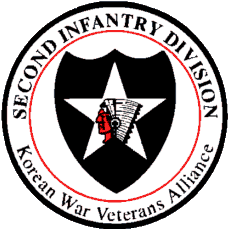 |
| Go here for another fine 2nd Indian Division site. |
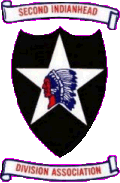 |
Servicemen involved in Korea: 3,421 Killed in action : 287 Wounded :1,350 Missing in action : 7 P.O.W. taken : 12
FRENCH NAVAL FORCES in KOREA (4 th Frigate Squadron Commonwealth - Task Group 90.4 then Minesweeping Group TG 95.6 US Navy)
Aviso La Grandière : 143 seamen from 8th July to 30th November 1950 Killed in action (before setting sail to Korean waters, by Viêt-Minh, Saïgon River) : 2
LC_R - National Councils Member (NAVY) of the A.N.A.F.F. ONU-R.C. (French Korean Veterans Association)
e-mail: lcr.fn.korean.vet@wanadoo.fr
(Reproduction autorisée avec mention d'origine - Other rights reserved)
FMS LA GRANDIÈRE
 Designed as Aviso Colonial de 1ère Classe (Class: Dumont d'Urville)- Pennant number: A 01 Laid down 1938 - Launched June 1939 - Completed 1940 - Built by A.C. PROVENCE Displacement: 1,969 tW (2,600 full load) Dimensions, meters: 103.70 x 12.70 X 4.80 Main Machinery : 2 Diesel Engines
Burmeister & Wain (Penhoët) 8,200 HP on two shafts Speed: 15.5 kts (Max. 17.5) Range, nm : 13,000 / 8.5 - 7,600 / 14.0 Armament: 3 x 5.5" (138mm) in three mountains, IV x 1 40mm bofors, XI x 1 20mm oerlikons A/S weapons: depth charges (66) and IV x 1 A/S mortars Complement: 135 (peace)
- 176 / 194 (war, with military lift) - 143 (war,without military lift)
Designed as Aviso Colonial de 1ère Classe (Class: Dumont d'Urville)- Pennant number: A 01 Laid down 1938 - Launched June 1939 - Completed 1940 - Built by A.C. PROVENCE Displacement: 1,969 tW (2,600 full load) Dimensions, meters: 103.70 x 12.70 X 4.80 Main Machinery : 2 Diesel Engines
Burmeister & Wain (Penhoët) 8,200 HP on two shafts Speed: 15.5 kts (Max. 17.5) Range, nm : 13,000 / 8.5 - 7,600 / 14.0 Armament: 3 x 5.5" (138mm) in three mountains, IV x 1 40mm bofors, XI x 1 20mm oerlikons A/S weapons: depth charges (66) and IV x 1 A/S mortars Complement: 135 (peace)
- 176 / 194 (war, with military lift) - 143 (war,without military lift)
HMS MOUNTS BAY
 Laid down in 1944 as a Loch Class Frigate K 627. Designed for Anti-Submarine and escort duties. Built by William Pickersgill & Sons Ltd at Sunderland. Launched 8th June 1945. Not completed. 1948 : re-designed for A.A. Escort and Convoy duties and re-classed a BAY CLASS FRIGATE. Completed at Southampton
by J I Thorneycroft and re-named "MOUNTS BAY" F627 Displacement 1,600 tons. Length overall 307 ft 4 ins. Beam 38 ft 6 ins. Draught 12 ft 9 ins. Armament: Four x 4" guns in two mountains. Six x 40mm Bofor`s. Two 20mm Oerlikons. A/S weapons Depth charges and Hedgehog. Propulsion: Two admiralty boilers serving a Triple Expansion Engine producing I.H.P.5,500 on twoscrews giving a maximum speed of 19 knots.
Laid down in 1944 as a Loch Class Frigate K 627. Designed for Anti-Submarine and escort duties. Built by William Pickersgill & Sons Ltd at Sunderland. Launched 8th June 1945. Not completed. 1948 : re-designed for A.A. Escort and Convoy duties and re-classed a BAY CLASS FRIGATE. Completed at Southampton
by J I Thorneycroft and re-named "MOUNTS BAY" F627 Displacement 1,600 tons. Length overall 307 ft 4 ins. Beam 38 ft 6 ins. Draught 12 ft 9 ins. Armament: Four x 4" guns in two mountains. Six x 40mm Bofor`s. Two 20mm Oerlikons. A/S weapons Depth charges and Hedgehog. Propulsion: Two admiralty boilers serving a Triple Expansion Engine producing I.H.P.5,500 on twoscrews giving a maximum speed of 19 knots.
Link to M. Rochotte's Page
Link to Jean Michel Roche's
Page
I would like to thank Léon Rochotte for his contribution to this section of my webpage.

 Korean War Page
Korean War Page
 Return to Mansfield Page
Return to Mansfield Page
 Return to Home Page
Return to Home Page
 Editor Note: About the author. Léon C. Rochotte entered the French Navy in 1949. He was on board the frigate FMS LA GRANDIÈRE (F 731) in Korean Waters from July until December 1950 and participated in the Inchon and Wonsan invasions. LA GRANDIÈRE was integrated into the Fourth Frigate Squadron (F4) and placed under British command for the operation. Rochotte left the French Navy in 1956 as a Petty Officer of the French Fleet Air Arm (15F-"Corsair" F4U7). He is a retired methods engineerand a member of the French Korean Veterans Association (A.N.A.F.F. ONU - R.C.) and the British Korean Veterans Association (B.K.V.A. South London Branch). He resides in St. Michel Sur Meurthe, France. Accounts involving HMS MOUNTS BAY (F 627) are extracted from Don Giles article "HMS MOUNTS
BAY in Korean Waters" originally published in french, in "Le Piton", FKWVA Bulletin, January 1998. Giles served in the Royal Navy aboard MOUNTS BAY in 1950 till 1952. MOUNTS BAY served as the F4 British flagship during the Inchon invasion in September 1950. It's force consisted of screen group, TG 90.4, then minesweeping group TG 95.6. He was on board MOUNTS BAY in Korean waters during the Inchon invasion. He is retired, and a member of the British Korean Veterans Association and resides in
Lincoln, United Kingdom. Others contributing to this article include Rear Admiral (then Lieutenant) Louis Tailhades, French Navy, Retired, and former French sailors, Lucien Charron, Gaston Brockly and Marcel Favry, all retired. Tailhades, Charron, Brockly and Favry all served aboard LA GRANDIÈRE during this period. (The author states that the opinions, citations, disgests and interpretations expressed in this article are his alone.)
Editor Note: About the author. Léon C. Rochotte entered the French Navy in 1949. He was on board the frigate FMS LA GRANDIÈRE (F 731) in Korean Waters from July until December 1950 and participated in the Inchon and Wonsan invasions. LA GRANDIÈRE was integrated into the Fourth Frigate Squadron (F4) and placed under British command for the operation. Rochotte left the French Navy in 1956 as a Petty Officer of the French Fleet Air Arm (15F-"Corsair" F4U7). He is a retired methods engineerand a member of the French Korean Veterans Association (A.N.A.F.F. ONU - R.C.) and the British Korean Veterans Association (B.K.V.A. South London Branch). He resides in St. Michel Sur Meurthe, France. Accounts involving HMS MOUNTS BAY (F 627) are extracted from Don Giles article "HMS MOUNTS
BAY in Korean Waters" originally published in french, in "Le Piton", FKWVA Bulletin, January 1998. Giles served in the Royal Navy aboard MOUNTS BAY in 1950 till 1952. MOUNTS BAY served as the F4 British flagship during the Inchon invasion in September 1950. It's force consisted of screen group, TG 90.4, then minesweeping group TG 95.6. He was on board MOUNTS BAY in Korean waters during the Inchon invasion. He is retired, and a member of the British Korean Veterans Association and resides in
Lincoln, United Kingdom. Others contributing to this article include Rear Admiral (then Lieutenant) Louis Tailhades, French Navy, Retired, and former French sailors, Lucien Charron, Gaston Brockly and Marcel Favry, all retired. Tailhades, Charron, Brockly and Favry all served aboard LA GRANDIÈRE during this period. (The author states that the opinions, citations, disgests and interpretations expressed in this article are his alone.) LA GRANDIÈRE (as CTU 90.04.3) joined Attack Force 90.42 and three minesweepers USS PARTRIDGE (AMS 31), USS OSPREY (AMS 28) and USS MOCKING BIRD (AMS 27). Also in the convoy were tugboats YTB406 and YN101, and three other fleet ocean tugs USS ARIKARA (ATF 98), USS LIPAN, and USS CREE (ATF 84) with their floating landing stage elements. The group was the first to depart Sasebo, Japan, while other groups had departed from several ports on the East Coast of Japan. We were passed on route by those groups who
had to be in position before the landing operations.
LA GRANDIÈRE (as CTU 90.04.3) joined Attack Force 90.42 and three minesweepers USS PARTRIDGE (AMS 31), USS OSPREY (AMS 28) and USS MOCKING BIRD (AMS 27). Also in the convoy were tugboats YTB406 and YN101, and three other fleet ocean tugs USS ARIKARA (ATF 98), USS LIPAN, and USS CREE (ATF 84) with their floating landing stage elements. The group was the first to depart Sasebo, Japan, while other groups had departed from several ports on the East Coast of Japan. We were passed on route by those groups who
had to be in position before the landing operations. On the 2nd of October our patrol was interrupted. Anchored off Wolmi Do Island we received a visit by Rear Admiral L. A. Thackrey, Commander, Amphibious Force Far East (TF 90). His visit was one of many visits by U.S. Officers of flag rank during the operation.
On the 2nd of October our patrol was interrupted. Anchored off Wolmi Do Island we received a visit by Rear Admiral L. A. Thackrey, Commander, Amphibious Force Far East (TF 90). His visit was one of many visits by U.S. Officers of flag rank during the operation.




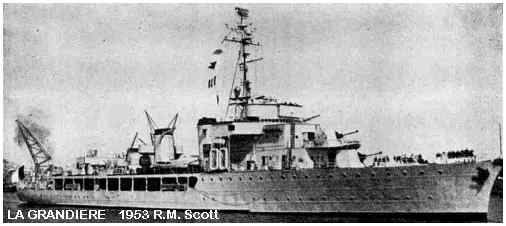
 Designed as Aviso Colonial de 1ère Classe (Class: Dumont d'Urville)- Pennant number: A 01 Laid down 1938 - Launched June 1939 - Completed 1940 - Built by A.C. PROVENCE Displacement: 1,969 tW (2,600 full load) Dimensions, meters: 103.70 x 12.70 X 4.80 Main Machinery : 2 Diesel Engines
Burmeister & Wain (Penhoët) 8,200 HP on two shafts Speed: 15.5 kts (Max. 17.5) Range, nm : 13,000 / 8.5 - 7,600 / 14.0 Armament: 3 x 5.5" (138mm) in three mountains, IV x 1 40mm bofors, XI x 1 20mm oerlikons A/S weapons: depth charges (66) and IV x 1 A/S mortars Complement: 135 (peace)
- 176 / 194 (war, with military lift) - 143 (war,without military lift)
Designed as Aviso Colonial de 1ère Classe (Class: Dumont d'Urville)- Pennant number: A 01 Laid down 1938 - Launched June 1939 - Completed 1940 - Built by A.C. PROVENCE Displacement: 1,969 tW (2,600 full load) Dimensions, meters: 103.70 x 12.70 X 4.80 Main Machinery : 2 Diesel Engines
Burmeister & Wain (Penhoët) 8,200 HP on two shafts Speed: 15.5 kts (Max. 17.5) Range, nm : 13,000 / 8.5 - 7,600 / 14.0 Armament: 3 x 5.5" (138mm) in three mountains, IV x 1 40mm bofors, XI x 1 20mm oerlikons A/S weapons: depth charges (66) and IV x 1 A/S mortars Complement: 135 (peace)
- 176 / 194 (war, with military lift) - 143 (war,without military lift)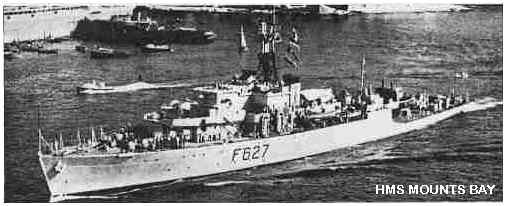
 Laid down in 1944 as a Loch Class Frigate K 627. Designed for Anti-Submarine and escort duties. Built by William Pickersgill & Sons Ltd at Sunderland. Launched 8th June 1945. Not completed. 1948 : re-designed for A.A. Escort and Convoy duties and re-classed a BAY CLASS FRIGATE. Completed at Southampton
by J I Thorneycroft and re-named "MOUNTS BAY" F627 Displacement 1,600 tons. Length overall 307 ft 4 ins. Beam 38 ft 6 ins. Draught 12 ft 9 ins. Armament: Four x 4" guns in two mountains. Six x 40mm Bofor`s. Two 20mm Oerlikons. A/S weapons Depth charges and Hedgehog. Propulsion: Two admiralty boilers serving a Triple Expansion Engine producing I.H.P.5,500 on twoscrews giving a maximum speed of 19 knots.
Laid down in 1944 as a Loch Class Frigate K 627. Designed for Anti-Submarine and escort duties. Built by William Pickersgill & Sons Ltd at Sunderland. Launched 8th June 1945. Not completed. 1948 : re-designed for A.A. Escort and Convoy duties and re-classed a BAY CLASS FRIGATE. Completed at Southampton
by J I Thorneycroft and re-named "MOUNTS BAY" F627 Displacement 1,600 tons. Length overall 307 ft 4 ins. Beam 38 ft 6 ins. Draught 12 ft 9 ins. Armament: Four x 4" guns in two mountains. Six x 40mm Bofor`s. Two 20mm Oerlikons. A/S weapons Depth charges and Hedgehog. Propulsion: Two admiralty boilers serving a Triple Expansion Engine producing I.H.P.5,500 on twoscrews giving a maximum speed of 19 knots.